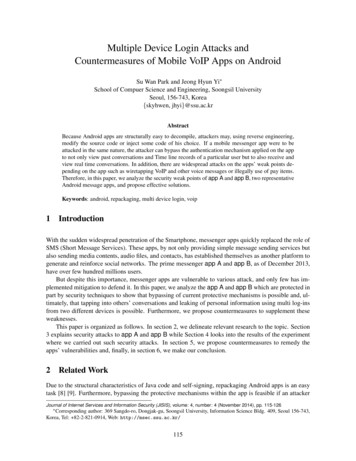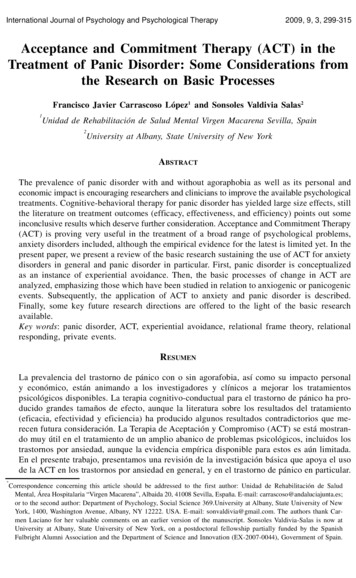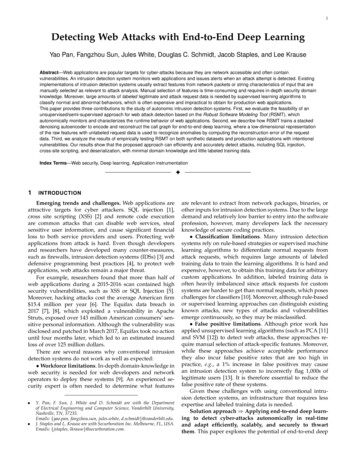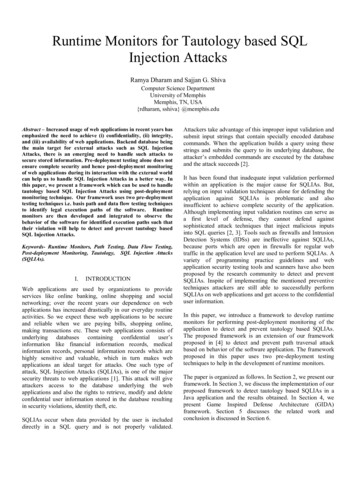
Transcription
Multiple Device Login Attacks andCountermeasures of Mobile VoIP Apps on AndroidSu Wan Park and Jeong Hyun Yi School of Compuer Science and Engineering, Soongsil UniversitySeoul, 156-743, Korea{skyhwen, jhyi}@ssu.ac.krAbstractBecause Android apps are structurally easy to decompile, attackers may, using reverse engineering,modify the source code or inject some code of his choice. If a mobile messenger app were to beattacked in the same nature, the attacker can bypass the authentication mechanism applied on the appto not only view past conversations and Time line records of a particular user but to also receive andview real time conversations. In addition, there are widespread attacks on the apps’ weak points depending on the app such as wiretapping VoIP and other voice messages or illegally use of pay items.Therefore, in this paper, we analyze the security weak points of app A and app B, two representativeAndroid message apps, and propose effective solutions.Keywords: android, repackaging, multi device login, voip1IntroductionWith the sudden widespread penetration of the Smartphone, messenger apps quickly replaced the role ofSMS (Short Message Services). These apps, by not only providing simple message sending services butalso sending media contents, audio files, and contacts, has established themselves as another platform togenerate and reinforce social networks. The prime messenger app A and app B, as of December 2013,have over few hundred millions users.But despite this importance, messenger apps are vulnerable to various attack, and only few has implemented mitigation to defend it. In this paper, we analyze the app A and app B which are protected inpart by security techniques to show that bypassing of current protective mechanisms is possible and, ultimately, that tapping into others’ conversations and leaking of personal information using multi log-insfrom two different devices is possible. Furthermore, we propose countermeasures to supplement theseweaknesses.This paper is organized as follows. In section 2, we delineate relevant research to the topic. Section3 explains security attacks to app A and app B while Section 4 looks into the results of the experimentwhere we carried out such security attacks. In section 5, we propose countermeasures to remedy theapps’ vulnerabilities and, finally, in section 6, we make our conclusion.2Related WorkDue to the structural characteristics of Java code and self-signing, repackaging Android apps is an easytask [8] [9]. Furthermore, bypassing the protective mechanisms within the app is feasible if an attackerJournal of Internet Services and Information Security (JISIS), volume: 4, number: 4 (November 2014), pp. 115-126 Correspondingauthor: 369 Sangdo-ro, Dongjak-gu, Soongsil University, Information Science Bldg. 409, Seoul 156-743,Korea, Tel: 82-2-821-0914, Web: http://msec.ssu.ac.kr/115
Multiple Device Login Attacks of application on AndroidPark and Yipinpoints the location of the code, while detecting the code location is uncomplicated. That is, if anattacker only determines the location of the protective mechanism routine of typical apps, one can manipulate the control flow through repackaging attack. The attacker can bypass the entire tamper detectionpart and also insert any faked value into the appropriate parameter.Figure 1: Overview of Android repackaging attackAs shown in Figure 1, the attacker may, using baksmali [1] and disassembler like IDA [5], easilyidentify the control flow of the source code and, using this information, may inject code into whateverdesired location. Because extracting anything from a signed file being impossible, the attacker lastlyassembles a new APK and signs it with a personal private key before proceeding to either personally useor even distribute the new APK.3Security AnalysisTable 1 shows the different security techniques applied to the major mobile messenger apps. Note thatwe analyze the latest version of app at that time. The results of reverse engineering on nine major apps,showed that the app A was the only one with a tamper detection feature and app A and app B werethe two that checked if a previously authenticated device is the current device in use, disallowing multilogins.Before we describe couple of attack vectors, need to address about analytical method. As said above,arbitrary code can be inserted to application. Main obstacle is how to find the code area we want tomodify. To solve this our analysis framework, which put particular code alerting monitoring tool to firstand end point of every function in appointed module, is used. So, we can build call graph of target app,and furthermore specific code location is able to be found by combining with string information. Detailmethods using the obtained data will be introduced in each subsection.116
Multiple Device Login Attacks of application on AndroidObfuscationTamper detectionDevice authenticationapp AOOOPark and Yiapp BOXOOthersOXXTable 1: Security techniques applied to each app3.1Multi Device LoginThis attack needs the victim’s credential files which is stored on the path:/data/data/appname, becauseapplication save the chat and connection information to those. Using repackaged or 3rd party app, extractthe file, and put the data to the device of the attacker. Almost of messenger, don’t apply any securitytechniques to protect from this attack, but app A and app B implement some functions. To bypass them,we perform the several thing as follows.3.1.1Bypassing Tamper DetectionWe will begin by talking about the app A. The app A puts relatively much consideration into securitywith very minimal empty space in its log and providing a tamper detection feature. However, oncewe decompile the app and search the string, one can see that there exist functions that leave a log andthat the functions that have, as one of theirs parameters, a string that appears as log is invoked. Toanalyze this part, after causing all logs to be outputted, we used the collected information to custombuild a tamper detection section. This is made possible if afterwards one creates a section that checkswhether the authentication information within the file aligns with the current device information afterone manipulates the return value and bypasses the area in concern while adding its credential into theapp folder. Figure 2 shows how to bypass the tamper detection methods for app A.Figure 2: Bypassing app A tamper detectionFor the app A app, while the kly function of the util/cr class executes tamper detection, if one insertsa code to ensure that this function returns only the true value, one can easily manipulate app A to runlike a typical app.117
Multiple Device Login Attacks of application on AndroidPark and YiIt is not with just these two methods that one can bypass detection. The majority of functions thatinspect particular sections are in the form shown in below.boolean CheckIntegrity(){ . }Although the function is structurally problem-free, the function will only return either a true or falsereturn value despite how complicated the internal logic. Due to this, the attacker only needs to find thelocation of the function using string or log and can disregard the complicated internal calculations tobypass detection without difficulty.3.1.2Bypassing Device AuthenticationLikewise, bypassing the authentication is possible using a similar method. But, mechanism of app B isslightly different with app A. For this app, the device ID is used in decrypting data so a specific valuemust be inserted.Figure 3 shows tampering to enable normal data decryption and duplicate access when one the deviceID of the login device is inserted even if the actual device in use differs.Figure 3: Modifying decryption routine on the app B118
Multiple Device Login Attacks of application on Android3.2Park and YiBypassing Item PaymentUsing above method, Figure 4 shows the method for bypassing the section that checks whether the itemis paid for or not. The app features can also be manipulated just as easily.Figure 4: Bypassing item payment checking for app A3.3VoIP HookingNext, let us examine VoIP hooking. Interestingly, the VoIP module does not exist on the smali code levelbut is located at .so library. Although the fact that one must deal with assembly code instead of smaliposes some difficulty, modifying the library is by no means impossible. In fact, because the native codein .so library is executed internally inside Dalvik VM [2] rather than externally, dynamic debugging,which makes following the flow of code and memory, becomes easier using the tools like gdb [3] inandroid ndk [6] and IDA [5].Because app A encrypts the moment it connects to VoIP, to gain an audio buffer that can playback, app A must hook with a function that uses the corresponding memory address of the particularfunction as a factor. Although there are multiple possible hooking points, the play or record functions,as functions provided by Android, are easy to pry into. Because the register value can change duringfunction execution, hooking occurs immediately before the play function or immediately after the recordfunction. Instead of executing the original code for the function, this will execute the code that divergesthe function containing the desired assembly. The corresponding custom function must, immediatelybefore and after executing its code, return to standard routine after summoning the originally called uponfunction while, also, save and restore the registers. Furthermore, because VoIP executes the receivingand transmitting sections separately, it is in need of a process that corresponds to both functions. For thetext section, because it lacked space to inject code, we created and summoned a new section. Figure 5,shown below, explains the aforementioned VoIP hooking process.Insert the modified library file into APK file or replace original file which is stored data path. Orthis can be performed in different way like binder hook or memory hacking from 3rd party app. Ifapp updates library file using insecure connection, this attack will be implemented more smoothly byperforming MITM attack.119
Multiple Device Login Attacks of application on AndroidPark and YiFigure 5: VoIP hooking mechanism4Experimental ResultsAfter bypassing tamper detection and the device authentication, one can use the credential files of adifferent user to allow multi-device login. If the multi-login is successful, the hacker is able to not onlyview the past user’s conversation records and list of friends as shown in Figure 6 below but can also sendor receive messages in real time.We confirmed this attack is possible not only app A and app B implementing security mechanism,but also the others. Of course, the latter apps are no trouble to do, because they don’t have to repackagefor control flow modification, and just need information files of victim device. Even some programsallow other applications to access their own data file. It makes remote attack using 3rd party app possiblein non root device.X120
Multiple Device Login Attacks of application on AndroidPark and YiFigure 6: Result from multi-device login with repackagingThe attackers can have unauthorized use of existing pay items, as shown in Figure 7, if one bypassesthe tamper detection and pay item inspection routine. In addition, the exposed control flow reveals theURL from which one can directly download pay items and the file containing authentication information,allowing downloading and even free distribution of pay items.Figure 7: Unauthorized use of pay items for app A121
Multiple Device Login Attacks of application on AndroidPark and YiWhen such code injection is applied to VoIP, an attacker is able to record, save, and send the contentsof a different user’s conversation. Figure 8, shown below, explains this process.Figure 8: VoIP hooking results5CountermeasuresThe tamper detection feature, device authentication, and other such features on the app A or app B areeasily bypassed. To supplement for these weak points, the following countermeasures can be considered.5.1Code Integrity CheckFirst, there is the server-based integrity checking method. Most commonly used for integrity checkingis the hash authentication method in the signature. The hash value is useful in verifying the integrity offalsified areas of a code that an attacker has repackaged. However, if this routine exists within the app’sinternals, the attacker can also tamper with this method as well, making this method insecure. For thisreason, we must send this signature value using the server without having the client internals verify thesignature. Because the transmission value may be exposed, SSL communications must fundamentally beused and to prevent attacks through memory dump, the memory area containing the hash string shouldbe immediately deallocated.The second method is providing necessary information to the registered client only if initial verification was successful. Currently, most apps use the method of running the integrity checking routine only122
Multiple Device Login Attacks of application on AndroidPark and Yionce and allowing the app to run normally if the return value from the checking is correct. This methodis very vulnerable to reverse engineering and leaves an identification flag within the server. It is onlygood to use this information sending method only when this flag is normal. If one uses this method, evenif an attacker were to repackage the app to make it appear as a normal app, one cannot gain informationfrom the server. Figure 9 shows the two proposed method used together.Figure 9: Server based integrity checking mechanismFor this to happen on an actual server, more elaborate verification must take place. We must keep inmind that because VoIP along with the library file could be falsified, simply using a signature value testdoes not suffice.5.2Dynamic Code InjectionBecause repackaging attacks occur statically, use of the dynamic code injection method hides the controlflow and makes code modification more difficult. The method of injecting code after receiving, throughcommunication with the server, the code to be rewritten minimizes the section made vulnerable to attackers. If one injects only a part of the contents of the function that executes the authentication process,executes that code, and then overwrites it back to the original code, attackers will have difficulty identifying the code using static analysis. Figure 10 gives a rough outline of the mechanisms of code injection.123
Multiple Device Login Attacks of application on AndroidPark and YiFigure 10: Dynamic code injection mechanism5.3Code ObfuscationMany apps currently do not use obfuscation and, even if they do, they use the Android provided Proguard[7]. As much as Proguard is provided for free, there are many known methods of bypassing and the levelof security is very low. As a result, applying the more highly secure obfuscation technique is good forhiding the API name, function name, and variable identifier. As the location of the security mechanismroutine can be easily inferred through the log or string variable, it is important to encode the stringvariable and discard the log.5.4Code AttestationAlthough obfuscation can run an analysis — with some difficulties due to the attacker — using theprotective mechanism of the application layer with static code protection techniques, when running theapp, it is difficult to protect the code. Supplementing this, to dynamically protect the code during theapp runtime, code attestation technology that uses protective hardware such as TEE (Trusted ExecutionEnvironment) [4] as the trusted point is needed. Using this, not only protecting the smartphone platformbut, by verifying the presence of tamper in the app, a more reliable protective service can be provided.6ConclusionUntil now, we have investigated how easily repackaging attacks on Android can occur. Although apprepackaging attacks can happen on all types of apps, the experiment confirmed that if such attack occurs124
Multiple Device Login Attacks of application on AndroidPark and Yion a mobile messenger app, security vulnerabilities such as exposure of real time messages using multilogin, free use of pay items, wiretapping of VoIP, etc. may arise.Because the concerns discussed in this paper can occur by simply installing an app even on devicesthat cannot be rooted, we recommend that all apps be downloaded and installed from the standard market.Also, even if a device has been rooted, one must always be mindful because, during the installation of adifferent app, the switching of the library file or a leak of the credential files of an unrelated package canoccur.For app developers, applying security methods such as code injection, code obfuscation, code attestation will prevent exposing the control flow, and continuous inspection of the integrity of the app willminimize repackaging attacks.AcknowledgementsThis research was supported in part by Global Research Laboratory (GRL) program through the NationalResearch Foundation of Korea (NRF) funded by the Ministry of Science, ICT, and Future Planning (NRF2014K1A1A2043029), and in part by the National Research Foundation of Korea (NRF) grant fundedby the Ministry of Education ][7][8][9]Baksmali. https://code.google.com/p/smali/.Dalvik vm. ex.html.gdb. http://www.gnu.org/software/gdb/.Global platform device specifications. .asp.Ida pro. https://www.hex-rays.com/products/ida/.ndk. html.Proguard. http://proguard.sourceforge.net.J. H. Jung, J. Y. Kim, H. C. Lee, and J. H. Yi. Repackaging attack on android banking applications and itscountermeasures. Wireless Personal Communication, 73(1):342–351, June 2013.Arxan Technologies. State of security in the app economy: Mobile apps under attack, 2013. https://www.arxan.com/assets/1/7/State of Security in the App Economy Report Vol. �———————————125
Multiple Device Login Attacks of application on AndroidPark and YiAuthor BiographySu wan Park received his B.S. degrees in Computer Science from Soongsil University, Seoul, Korea in 2013. He is a M.S student in the Graduate School of InformationSecurity at KAIST. His research interests include mobile application and platformsecurity.Jeong Hyun Yi is an Assistant Professor in the School of Computer Science andEngineering at Soongsil University, Seoul, Korea. He received the B.S. and M.S. degrees in computer science from Soongsil University, Seoul, Korea, in 1993 and 1995,respectively, and the Ph.D. degree in information and computer science from the University of California, Irvine, in 2005. He was a Principal Researcher at Samsung Advanced Institute of Technology, Korea, from 2005 to 2008, and a member of researchstaff at Electronics and Telecommunications Research Institute (ETRI), Korea, from1995 to 2001. Between 2000 and 2001, he was a guest researcher at National Institute of Standards andTechnology (NIST), Maryland, U.S. His research interests include mobile security and privacy, networksecurity, cloud computing security, and applied cryptography. Some of his notable research contributionsinclude Certificate Management Protocol (CMP) for Korean PKI Standards and integration of Korea PKIand U.S. Federal PKI.126
Multiple Device Login Attacks of application on Android Park and Yi Figure 5: VoIP hooking mechanism 4 Experimental Results After bypassing tamper detection and the device authentication, one can use the credential files of a different user to allow multi-device login. If the multi-login is successful, the hacker is able to not only










